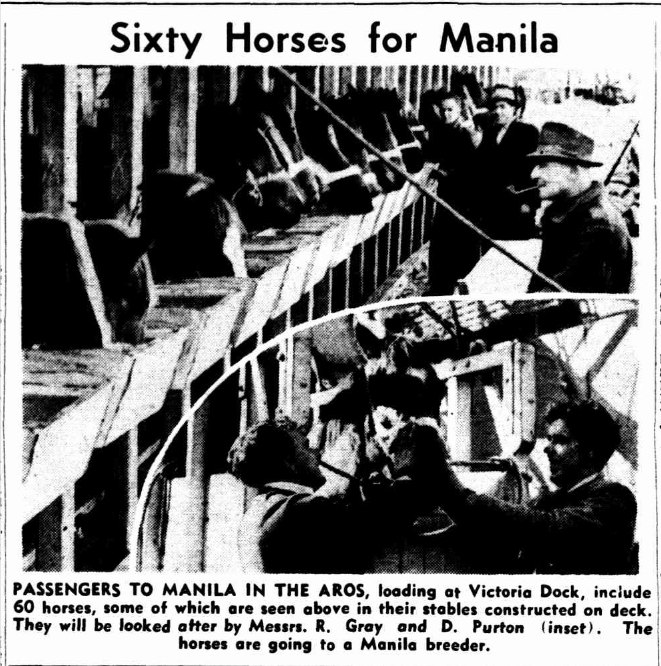Walers in the Philippines
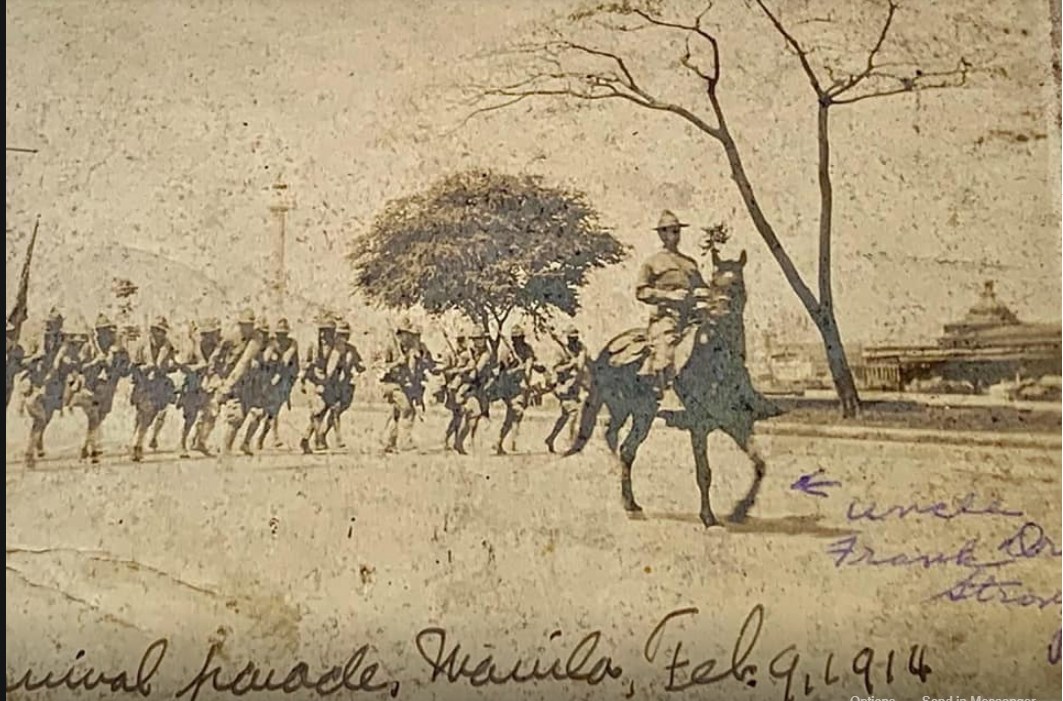
Waler Data Base @ Facebook. Image: Arrival parade, Manila. Feb. 1914. Patricia Boyle Family Collection.
Lovely photo kindly sent in by Patricia Boyle recently. It’s her great uncle, a medical doctor and Captain in the American army, on his horse, leading an arrival parade in Manila in 1914.
Although we usually post Australian photos, it’s of great interest as the horse may well be Australian.
Before North America took over the Philippines in 1898, we’d had a good horse trade to the Spanish there, who’d been the occupiers for 333 years. After a few hiccups, our horse trade continued to the American occupiers (they left the Philippines, so it regained independence a couple of years after WW2).
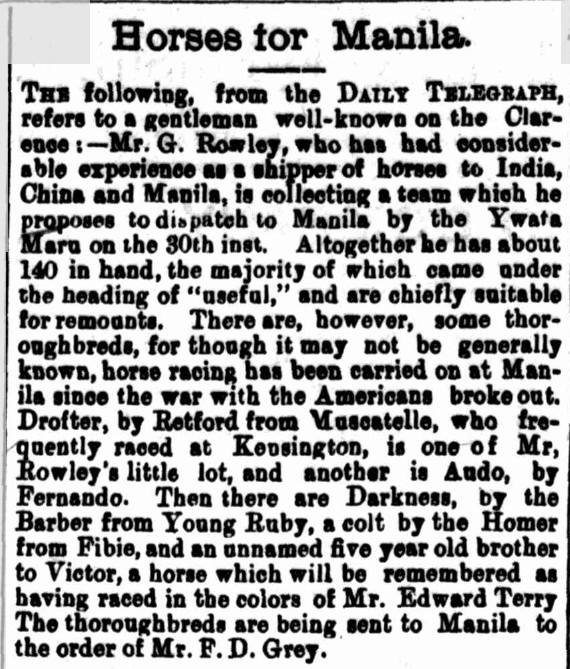
Image: Clarence River Advocate, 11th August 1899
Just to show we were trading immediately after the Americans took over, mostly remount types but also some racehorses.
George Rowley was a great horse trader, he sent thousands to Japan among other places and like all good traders, was a good diplomat.
Image: Australian Town & Country Journal, 11th December 1897
In the days of the Spanish having the Philippines, we sold horses there for agricultural work, trams, carriages, military, hacks and so on. There were good trade relationships although the trade in horses there was relatively small.
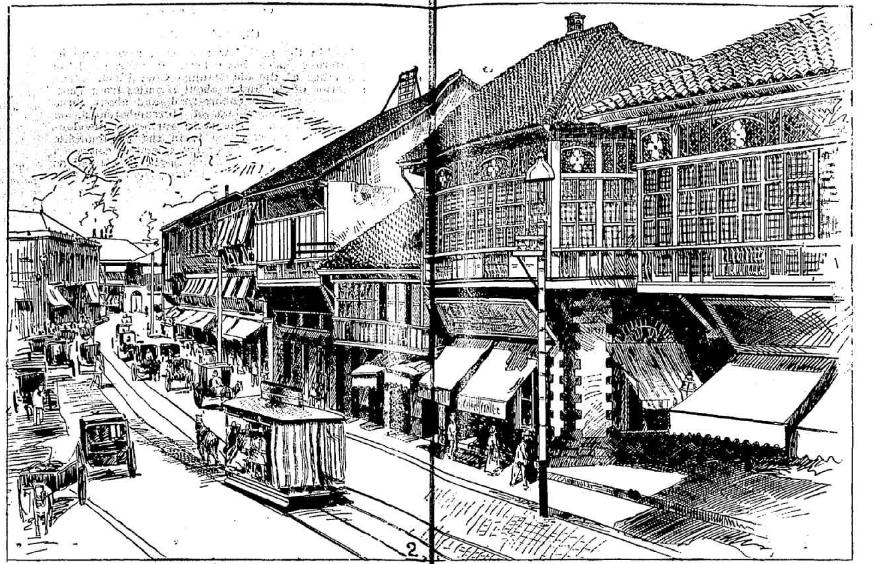
There were good hardy little native ponies there, although a bit small for some uses. The Moro horses of the Moro people was a famous breed, the size of a Galloway and very strong, possibly extinct now.

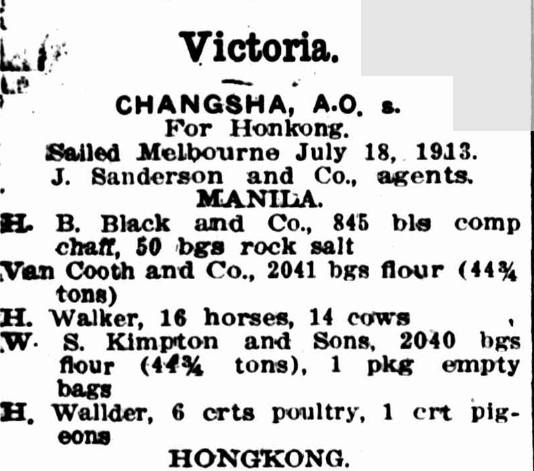
Image: Daily Commercial News & Shipping List, 5th August, 1913
A typical shipping list, showing 16 horses going on the Changsha from Victoria to Manila. These may have been going to an order for the army, but more likely to a bazaar to be auctioned. The army also bought at horse auctions there.
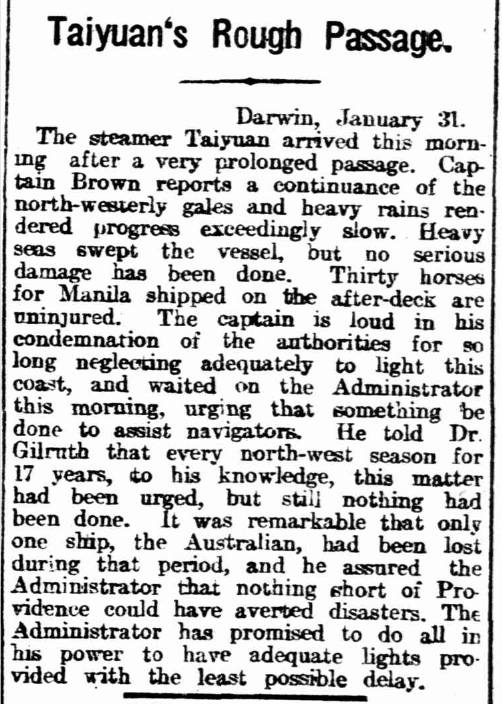
Americans in the Philippines bought our horses for military use, polo ponies, hacks and carriage horses. After they left, the horse trade continued to the Philippines army, they bought even more from us, well into the late 1950’s as well as polo ponies. By then of course, horses were becoming increasingly redundant for the army and the trade petered out everywhere.
Image: Brisbane Courier, 29th October 1913…
This sort of news item occurred often. American army buyers had been coming here since 1899. They travelled about getting horses suited for their army. Their budget was very small early on, for many years, so they had to look at a lot, and travel a lot to get horses at the price they could afford.
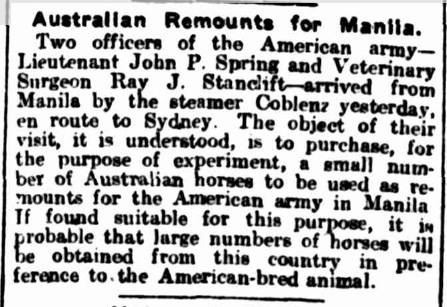
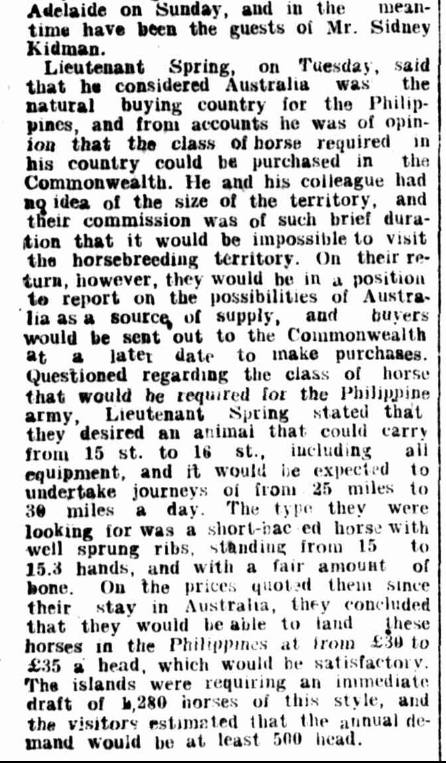
Image: Telegraph, 5th December 1918
We were getting top prices globally and sending thousands of horses away annually. In 1907 some of their officers came over and bought a lot, mostly heavy ponies, as it was all they could afford but they were good strong ponies.
These officers had a reasonable budget. They couldn’t afford Queensland horses (then getting the best prices) but persevered and went to Adelaide and met Sir Sid Kidman, who arranged some for them.
Sid was the biggest landowner in the world and a keen horseman and horse breeder.
Donald McInnes, one of the great characters of the Australian horse trade, traded a lot of horses and ponies there and even set up a bazaar in Manila, where horses were auctioned and sold to Americans and wealthy locals.
The horse in our feature photo looks like a Waler to me! but who knows. The Americans also sent horses there from their own country, they were very good horses but it was such a long trip, it was easier to get them from Australia. They also sent mules there from America but their survival rate was extremely low, perhaps due to the climate. We sent a few mules over too, not many, and they bought another few hundred mules from China.
We sent horses to the Philippines for a long time, of interest as it was all part of our horse trade. Most were for military use but many also for racing, polo, sugar cane plantations and so on. We couldn’t trade horses or ponies back here due to quarantine.
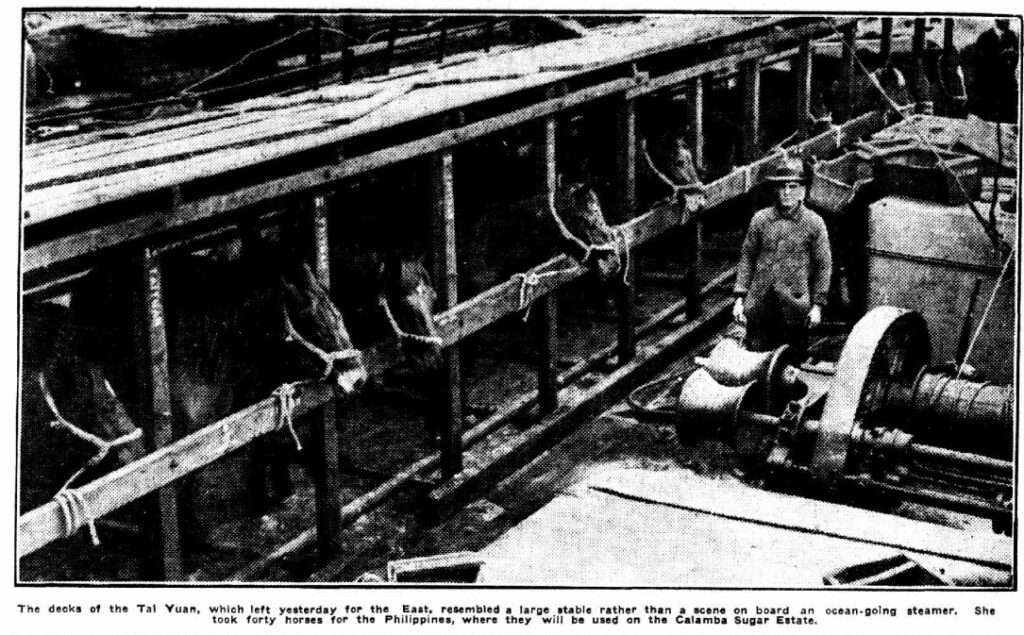
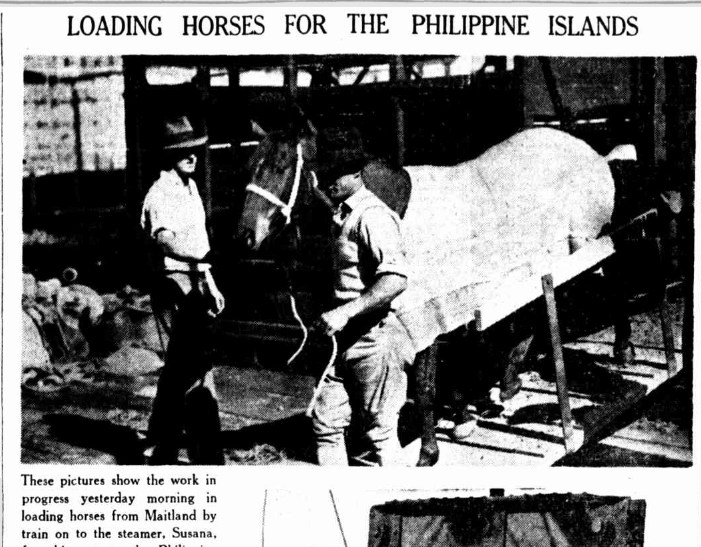
Images: Daily Telegraph (Sydney), 12th June 1924 Horses going over for work. Heavy types were sold to many countries for work, primarily in sugar plantations. These are the same types used for artillery and other military harness work; Newcastle Morning Herald and Mining Advocate, 31st June, 1936.
Manila was the first port of call for trade ships also taking horses to Java and India. Ports I’ve found our ships taking horses to were Manila and Ilo Ilo, but there may have been others.
Image: Newcastle Morning Herald and Miners Advocate, 9th September 1936
Horses going over for military use.
Between 1899 and 1902 we sent over 20,000 horses over. Trade petered out 1907 to 1913. Then picked up again. Went for military, work, polo, hacks, carriages.
Some Australians had also moved there and had sugar plantations and sent for work horses.
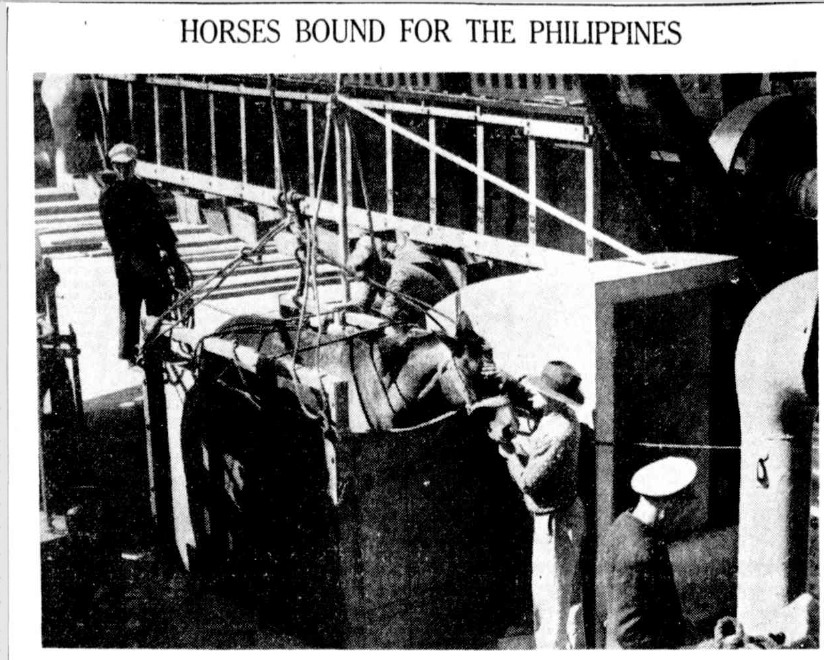
We sold many polo ponies to the Philippines – the Elizaldes brothers, Joachin (Miguel), Manolo (Mike), Juan and Angel were great customers. The Manila Polo Club started in 1909. William Cameron Forbes, a banker and diplomat, funded the creation of an excellent field and facilities. It boomed. The Los Tamaros Polo Club started in 1937, with 35 Australian horses imported by Joachin Elizalde, one of the famous polo brothers who founded the club, ace players.
Joachin, known better by his middle name Miguel, had been over in 1936, buying at West Maitland and playing here – dismayed at the state of our polo grounds but too polite to say other than he’d had a wonderful time and one may find the better the ground, the better the polo! His wife, an excellent horse woman, accompanied him. The Elizaldes team thrashed the Australian team from the Hunter at the inauguration of their club.
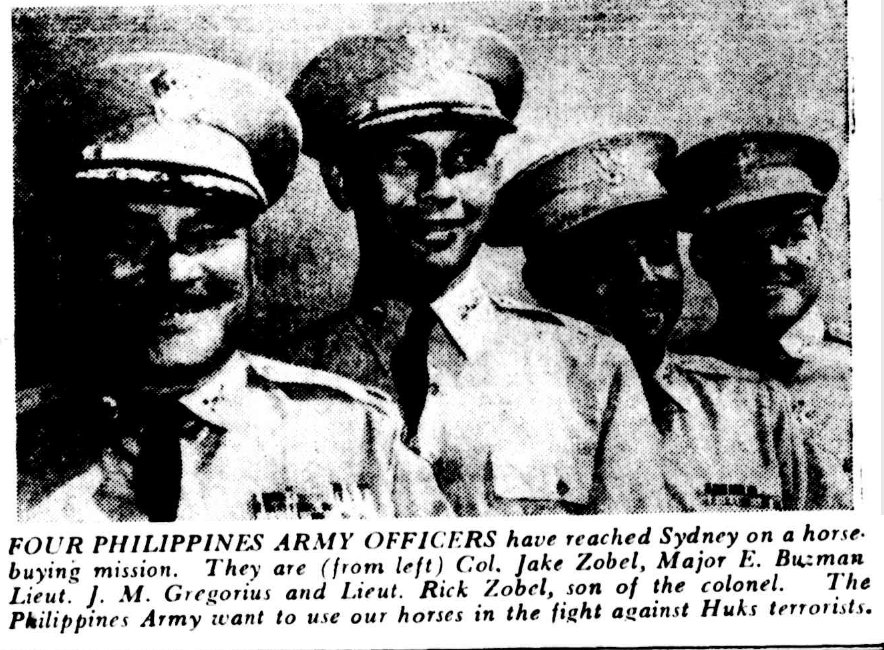
Image: Barrier Miner (Broken Hil NSW) 31st March 1952
The Zobel family were tremendous polo players. These men bought over 1,000 horses from us for military uses in the Philippines in 1952. They were welcomed here as friendships were already made through polo and it was fabulous to have someone buying our horses right at the end of the trade days. They were given dinner at Government House.
Horses were always a tremendous way for countries to get along. We could compete at sport and win or lose without killing each other. In China for example in the 1800’s and early 1900’s, British, Germans, Russians, Japanese and Americans stationed there all raced ponies against each other (griffin racing) and went on paper chase hunts and other activities, it created much good will. And was a very good market for us too, ha.
Polo was still being played and a good way for countries to get along on a diplomatic footing and make friends. When we took horses over to the Philippines, we couldn’t bring them back, due to our quarantine laws. So usually horses were borrowed while there or were left: there – gifted or sold. Interesting to see they were playing on mostly Australian horses anyway. Probably largely TB bred. Of interest even in 1941, WW2, we were sending racehorses to the Philippines and other places. War doesn’t stop the sport of the rich.
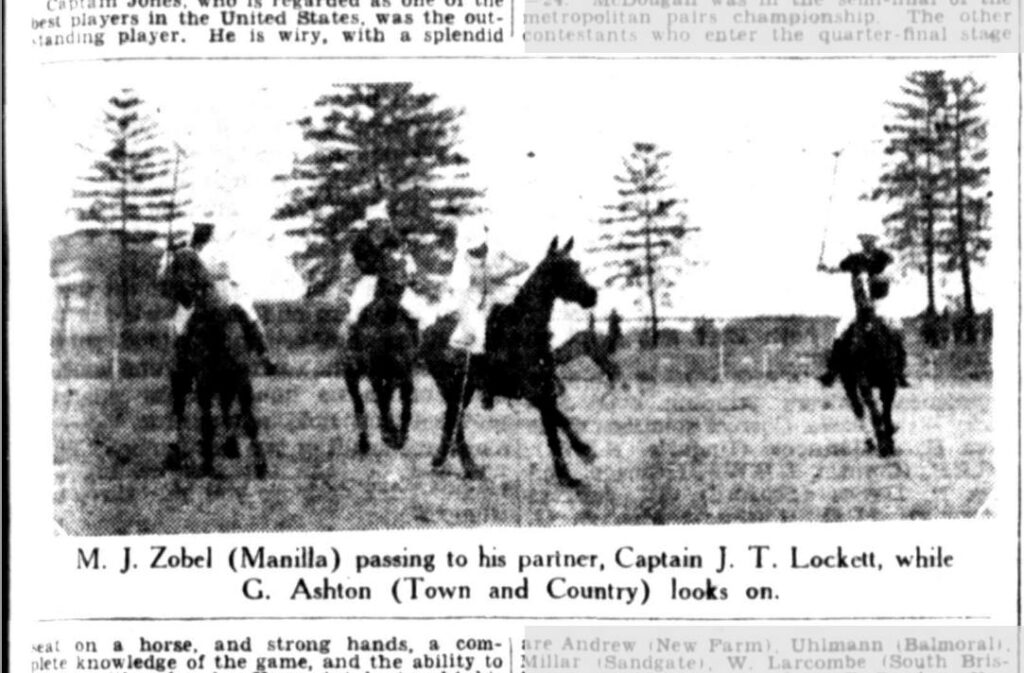
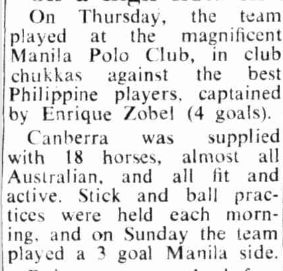
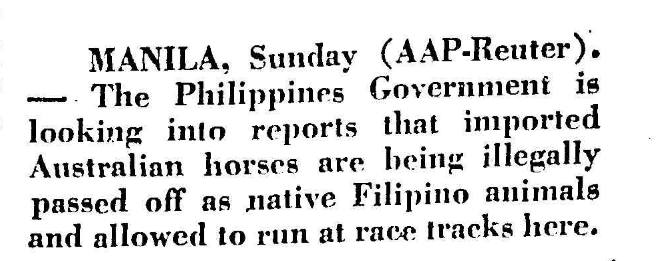
Image: Canberra Times, 20th June 1966
Of interest, as the main use for horses by the 1960s was racing. There was a lot of skullduggery then as now in that “industry.”
It was made law that horses bred in the philippines must be branded by 6 months old, to prevent soem of this shenanigans of putting a local brand on an unbranded Australian import.
There was a very lively trade and it’s more than probable some of these horses ended up as hacks and for some military use such as the Security Patrol. By this date the trade in Walers was over and no-one was breeding them. Horses had been out of fashion and out of use for a while. Most here then were Thoroughbreds or Standardbreds.
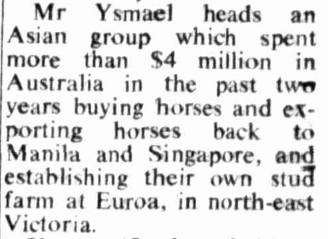
Image: Canberra Times 4th January 1969
Story about some people including Australians being rubbed out of racing in Victoria for two years over fixing a race here. Just of interest, to show the big market of Thoroughbreds to the Philippines. Hence being available there for uses other than racing.
